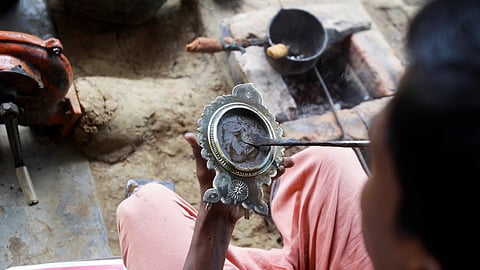
- Destinations
- Experiences
- Stay
- What's new
- Celebrating People
- Responsible Tourism
- CampaignsCampaigns
- SubscribeSubscribe
- Buy Now

Only a few kilometres from Kerala’s capital, Thiruvannathapuram, is the picturesque village of Aranmula. On the banks of the river Pampa in the village lies the famous Parthasarathy temple, which was constructed by artisans who were invited by the king from Sankaran Koil near Tirunelveli.
These artisans discovered the reflective quality of a copper-tin alloy, which began the journey and tradition of Aranmula Kannadi, or mirror making, in the village. Kannadi is the Malayalam word for mirror.
The names and composition of the metals used to create these unique handmade mirrors, free of distortions and secondary reflections, is a well-kept secret. In the Aranmula village of Kerala, members of a handful of Vishwakarma families are keeping the 250-300-year-old craft alive. [To read about GI products of Kerala, click here]
The birth story of the mirror-making craft is linked to the Parthasarathy temple in the village. Legend says that after observing a crack in the deity's crown, the local king summoned the makers, who were ordered to remake the crown in three days.
While remaking it, the makers accidentally stumbled upon a unique reflective property of an alloy comprising copper and tin. These craftsmen later tried different compositions with the metals, which eventually led to the standards for making the metal mirror.
Noted for their outstanding beauty, the metals used to make these mirrors and their composition remain shrouded and are only known to the families still involved in making them. Most households keep the mirror, considered an auspicious object that will bring wealth, prosperity, and luck to the house.
They also form a part of the ashtamangalaya set, a set of eight auspicious items usually arranged and displayed at religious ceremonies, functions, and occasions like marriage. This is an important tradition in the South-Indian state of Kerala.
The first step in creating the mirror is preparing the metal alloy. Great attention is paid to striking the right composition of copper, tin, and other metals. Once that is achieved, the alloy is melted inside a Kowa furnace and poured into a mould to create a flat circular base.
The next step of the process involved polishing. Once the base is prepared, it is polished using a series of abrasive materials like coconut shells to make it smooth. Next, a special tool called aruva is used to etch intricate details on the back of the mirror. This is followed by a long polishing process that can go anywhere between 1-2 days.
The final polishing of the mirror takes place using a velvet cloth. Some sources and local myths also believe that a special herbal powder is added to the molten metal that renders the shine to the Aranmula Kannadi.
The craft of making these mirrors is laborious and time-consuming, and it has been passed down from one generation to the next.
For proper maintenance, the mirror should be placed at room temperature, away from heat and dust. A prescribed set of methods must also be used to clean the mirror and remove finger stains. It should be wiped in a particular direction rather than all over.
Aranmula is well-connected by road, rail, and air. The nearest major bus stand is in Chengannur, located around 10 km from Aranmula, with regular services from nearby cities and towns. For those arriving by train, Chengannur Railway Station is also about 10 km away and is the closest railhead. If you're flying in, the nearest airport is Trivandrum International Airport, situated approximately 117 km from Aranmula, with road transport options available for the onward journey.
Begin your journey at the Aranmula Parthasarathy Temple, a revered 1700-year-old shrine dedicated to Lord Krishna, celebrated for its intricate architecture and spiritual significance. Time your visit around Onam to witness the spectacular Aranmula Boat Race, where beautifully decorated snake boats glide across the river in rhythmic unison. Don’t miss the chance to explore the making of the famed Aranmula Kannadi—handmade metal mirrors that are both artistic marvels and cultural heirlooms. Wander through the village to admire traditional Kerala homes, interact with local artisans, and soak in the peaceful riverside scenery.
